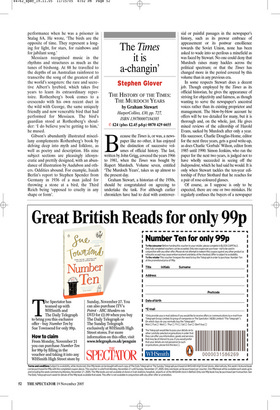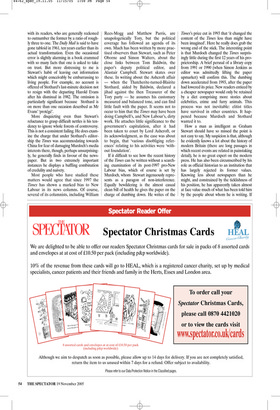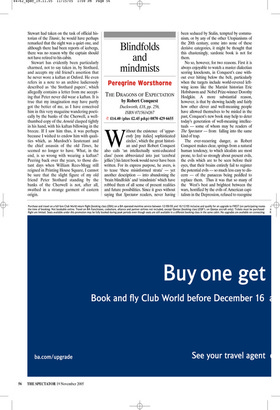The Times
it is a-changin’
Stephen Glover
THE HISTORY OF THE TIMES: THE MURDOCH YEARS by Graham Stewart HarperCollins, £30, pp. 727, ISBN 139780007184385 ✆ £24 (plus £2.45 p&p) 0870 429 6655 Because the Times is, or was, a newspaper like no other, it has enjoyed the distinction of successive volumes of official history. The last, written by John Grigg, covered the years 1966 to 1981, when the Times was bought by Rupert Murdoch. Volume seven, entitled ‘The Murdoch Years’, takes us up almost to the present day.
Graham Stewart, a historian of the 1930s, should be congratulated on agreeing to undertake the task. For although earlier chroniclers have had to deal with controver sial or painful passages in the newspaper’s history, such as its prewar embrace of appeasement or its postwar emollience towards the Soviet Union, none has been asked to wade into so perilous a minefield as was faced by Stewart. No one could deny that Murdoch raises many hackles across the political spectrum; or that the Times has changed more in the period covered by this volume than in any previous era.
In some respects Stewart does a decent job. Though employed by the Times as its official historian, he gives the appearance of striving for objectivity and fairness, as though wanting to serve the newspaper’s ancestral voices rather than its existing proprietor and management. The blow-by-blow account he offers will be too detailed for many, but it is thorough and, on the whole, just. He gives mixed reviews of the editorship of Harold Evans, sacked by Murdoch after only a year. His successor, Charlie Douglas-Home, editor for the next three years, gets a good write-up, as does Charlie ‘Gorbals’ Wilson, editor from 1985 until 1990. Simon Jenkins, who ran the paper for the next two years, is judged not to have wholly succeeded in seeing off the Independent, which he had said he would. It is only when Stewart tackles the ten-year editorship of Peter Stothard that he reaches for a pair of rose-coloured glasses.
Of course, as I suppose is only to be expected, there are one or two mistakes. He regularly confuses the buyers of a newspaper with its readers, who are generally reckoned to outnumber the former by a ratio of roughly three to one. The Daily Mail is said to have gone tabloid in 1961, ten years earlier than its actual transformation. Even the occasional error is slightly alarming in a book crammed with so many facts that one is asked to take on trust. But more distressing to me is Stewart’s habit of leaving out information which might conceivably be embarrassing to living people. For example, no account is offered of Stothard’s last-minute decision not to resign with the departing Harold Evans after his dismissal in 1982. The omission is particularly significant because Stothard is on more than one occasion described as Mr Evans’ ‘protégé’.
More disquieting even than Stewart’s reluctance to grasp difficult nettles is his tendency to ignore whole forests of controversy. This is not a consistent failing. He does examine the charge that under Stothard’s editorship the Times was accommodating towards China for fear of damaging Murdoch’s media interests there, though, perhaps unsurprisingly, he generally finds in favour of the newspaper. But in two extremely important instances he displays a baffling combination of credulity and naivety.
Most people who have studied these matters would agree that since 1997 the Times has shown a marked bias to New Labour in its news columns. Of course, several of its columnists, including William Rees-Mogg and Matthew Parris, are unapologetically Tory, but the political coverage has followed an agenda of its own. Much has been written by more practised observers than Stewart, such as Peter Oborne and Simon Walters, about the close links between Tom Baldwin, the paper’s deputy political editor, and Alastair Campbell. Stewart skates over these. In writing about the Ashcroft affair — when the Thatcherite-turned-Blairite Stothard, aided by Baldwin, declared a jihad against the then Treasurer of the Tory party — he assumes his customary measured and balanced tone, and can find little fault with the paper. It seems not to occur to him that the Times may have been doing Campbell’s, and New Labour’s, dirty work. He attaches little significance to the government’s capitulation, after it had been taken to court by Lord Ashcroft, or its acknowledgment, as the case was about to begin, that ‘various disobliging references’ relating to his activities were ‘without foundation’.
If it difficult to see how the recent history of the Times can be written without a searching examination of its post-1997 pro-New Labour bias, which of course is set by Murdoch, whom Stewart ingenuously represents as a paragon of non-interference. Equally bewildering is the almost casual clean bill of health he gives the paper on the charge of dumbing down. He writes of the Times’s price cut in 1993 that ‘it changed the content of the Times less than might have been imagined’. Here he really does grab the wrong end of the stick. The interesting point is that Murdoch changed the Times surprisingly little during the first 12 years of his proprietorship. A brief perusal of a library copy from 1991 or 1990 (when Simon Jenkins as editor was admittedly lifting the paper upmarket) will confirm this. The dumbing down accelerated from 1993, after the paper had lowered its price. New readers enticed by a cheaper newspaper would only be retained by a diet comprising more stories about celebrities, crime and furry animals. This process was not inevitable: elitist titles have survived in other countries. It happened because Murdoch and Stothard wanted it to.
How a man as intelligent as Graham Stewart should have so missed the point is not easy to say. My suspicion is that, although he evidently knows a lot about the history of modern Britain (there are long passages in which recent events are related in painstaking detail), he is no great expert on the modern press. He has also been circumscribed by his role as official historian to an institution that has largely rejected its former values. Knowing less about newspapers than he might, and constrained by the ticklishness of his position, he has apparently taken almost at face value much of what has been told him by the people about whom he is writing. If Stewart had taken on the task of official historian of the Titanic, he would have perhaps remarked that the night was a quiet one, and although there had been reports of icebergs, there was no reason why the captain should not have retired to his cabin.
Stewart has evidently been particularly charmed, not to say taken in, by Stothard, and accepts my old friend’s assertion that he never wore a kaftan at Oxford. He even refers in a note to an archive ludicrously described as ‘the Stothard papers’, which allegedly contains a letter from me accepting that Peter never did wear a kaftan. It is true that my imagination may have partly got the better of me, as I have conceived him in this very magazine wandering poetically by the banks of the Cherwell, a wellthumbed copy of the Aeneid clasped tightly in his hand, with his kaftan billowing in the breeze. If I saw him thus, it was perhaps because I wished to endow him with qualities which, as Murdoch’s lieutenant and the chief assassin of the old Times, he seemed no longer to have. What, in the end, is so wrong with wearing a kaftan? Peering back over the years, to those distant days when William Rees-Mogg still reigned in Printing House Square, I cannot be sure that the slight figure of my old friend Peter Stothard standing by the banks of the Cherwell is not, after all, swathed in a strange garment of eastern origin.



























































 Previous page
Previous page